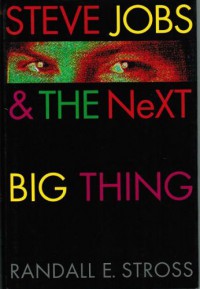
A fascinating story that isn't told enough times in book form -- Steve Jobs's post-Apple attempt to come up with the next great computing platform. After he was ousted from his day-to-day role at Apple, Jobs resigned and took a number of employees with him to form Next Inc, which would make computers for universities. While the hardware ultimately failed because it was too expensive, the software eventually became the basis for the Apple Store, the iTunes Store, macOS, iOS, watchOS, tvOS, and audioOS. The story of Jobs's journey there and back again, so to speak, is one of the most entertaining in the history of the industry.

A great visualization of the novel. It's nice to see the characters as Pullman describes them and the story done in the spirit much closer to the original than the movie.

Dreams and memories float in and out of the main narrative concerning a woman who visits her older friend in a hospice. Both are dealing with post-Brexit Britain in humorous, cultured ways which may ultimately not be enough, funny as the novel is. Done in an experimental style that recalls BS Johnson at times, but not at all difficult to read.

Sadie and Ratz are the names of Hannah's hands. They aren't animals, but they behave like wild beasts, says Dad. For one thing, they're always after four-year-old Baby Boy (whom Sadie wishes were a dog). They jump onto his head and try to rub his ears off. Baby Boy knows how to turn the tables, though, and when he spills milk on the carpet, he tells Grandma that Sadie and Ratz pushed him. But when Baby Boy goes too far, Hannah may have to send Sadie and Ratz on vacation to prove their innocence. Multi-award-winning author Sonya Hartnett brings her original sensibility, wry humor, and engaging characters to a younger audience, aided by Ann James's inviting illustrations.

This book is great for anyone no matter their level of knowledge about the art of the Renaissance. The reproductions are quite good. Panofsky ably details the iconology found across the arts and its common meaning.

The definitive look at Caravaggio and ideal for the lay reader. He captured the violent struggles of the Inquisition and Counter-Reformation, changing art forever. He did this by finding his own path very different from this of his peers. The struggles to do this are mirrored in his life, as the book details admirably. 5 stars.
www.goodreads.com/review/show/2125074597

 A Legacy of Spies by John le Carré
A Legacy of Spies by John le Carré
My rating: 4 of 5 stars
A coda to the Smiley saga, though it's more a bookend to "Spy Who Came in From the Cold" than the Karla trilogy. Felt like "Secret Pilgrim," and Peter Guillam reminded me of Ned in the way he drags himself through his own elegy and the Circus's. A quick read for le Carre, especially for a Circus book, and some of his reported disappointment with Sisman's biography shows up here in the book's anger about legacy and what it means. This feels like a summing up for le Carre, but hopefully like Miyazaki after "The Wind Rises," it'll turn out he has more tricks up his sleeve.
View all my reviews

Christine, a Victorian debutante, suffers from visions that connect her to a man endangered in another time and afflict her with a deep psychic sickness slowly killing her unless she finds a way to save the man and thus stop the visions. When the only person who can help her demands a devil's bargain, Christine must decide between betraying family and saving her own life.



